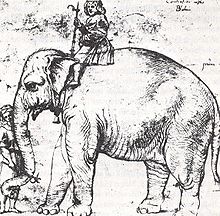Hanno (elephant)
This article includes a list of general references, but it lacks sufficient corresponding inline citations. (February 2011) |




Hanno (Italian: Annone; c. 1510 – 8 June 1516) was the pet white elephant given by King Manuel I of Portugal to Pope Leo X (born Giovanni de' Medici) at his coronation. Hanno, an Asian elephant, came to Rome in 1514 with the Portuguese ambassador Tristão da Cunha and quickly became the Pope's favorite animal. Hanno died two years later from complications of a treatment for constipation with gold-enriched laxative.[1]
Background
[edit]King Manuel had either received him as a gift from the Raja of Cochin, or had asked Afonso de Albuquerque, his viceroy in India, to purchase him. Hanno was said to be white in colour, and arrived by ship from Lisbon to Rome in 1514, aged about four years, and was kept initially in an enclosure in the Belvedere courtyard, then moved to a specially constructed building between St. Peter's Basilica and the Apostolic Palace, near the Borgo Sant'Angelo (a road in the rione of Borgo). His arrival was commemorated in poetry and art. Pasquale Malaspina wrote:
In the Belvedere before the great Pastor
Was conducted the trained elephant
Dancing with such grace and such love
That hardly better would a man have danced:
And then with its trunk such a great noise
It made, that the entire place was deafened:
And stretching itself on the ground to kneel
It then straightened up in reverence to the Pope,
And to his entourage.
Hanno became a great favourite of the papal court and was featured in processions. Two years after he came to Rome, he fell ill suddenly, was given a purgative, and died on 8 June 1516, with the pope at his side. Hanno was interred in the Cortile del Belvedere at the age of seven.
The artist Raphael designed a memorial fresco (which does not survive), and the Pope himself composed the epitaph:
Under this great hill I lie buried
Mighty elephant which the King Manuel
Having conquered the Orient
Sent as captive to Pope Leo X.
At which the Roman people marvelled, --
A beast not seen for a long time,
And in my brutish breast they perceived human feelings.
Fate envied me my residence in the blessed Latium
And had not the patience to let me serve my master a full three years.
But I wish, oh gods, that the time which Nature would have assigned to me,
and Destiny stole away,
You will add to the life of the great Leo.
He lived seven years
He died of angina
He measured twelve palms in height.
Giovanni Battista Branconio dell'Aquila
Privy chamberlain to the pope
And provost of the custody of the elephant,
Has erected this in 1516, the 8th of June,
In the fourth year of the pontificate of Leo X.
That which Nature has stolen away
Raphael of Urbino with his art has restored.
Hanno was also the subject of a satirical pamphlet by Pietro Aretino titled "The Last Will and Testament of the Elephant Hanno." The fictitious will cleverly mocked the leading political and religious figures of Rome at the time, including Pope Leo X himself. The pamphlet was such a success that it kickstarted Aretino's career and established him as a famous satirist, ultimately known as "the Scourge of Princes".
There are four sketches of Hanno, done in life with red chalk, in the collection of the Ashmolean Museum at Oxford.
In popular culture
[edit]Hanno's story is told at length in Silvio Bedini's book, The Pope's Elephant. According to Robert Greene, Aretino's audacious satire catapulted him to fame and, such was Leo's amusement, earned him a post in the papal service.[2]
The Malayalam novel "Aano" Written by G. R. Indugopan is the story of this elephant and its mahout who travelled in Europe as their perspective
See also
[edit]References
[edit]- ^ "Hanno (elephant)".
- ^ The 48 Laws of Power, p. 232
Further reading
[edit]- Silvio A. Bedini, The Pope's Elephant, Carcanet Press, 1997, ISBN 1-85754-277-0
- Annemarie Jordan Gschwend, The Story of Süleyman: Celebrity Elephants and Other Exotica in Renaissance Portugal, Pacyderm, 2010, ISBN 978-1-61658-821-2
- José Saramago, The Elephant's Journey, Mariner Books, 2008, ISBN 978-0547574110
